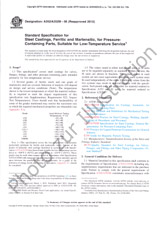Wir benötigen Ihre Einwilligung zur Verwendung der einzelnen Daten, damit Sie unter anderem Informationen zu Ihren Interessen einsehen können. Klicken Sie auf "OK", um Ihre Zustimmung zu erteilen.
ASTM E2889-12(2017)
Standard Practice for Control of Respiratory Hazards in the Metal Removal Fluid Environment
Name übersetzen
NORM herausgegeben am 1.10.2017
Informationen über die Norm:
Bezeichnung normen: ASTM E2889-12(2017)
Anmerkung: UNGÜLTIG
Ausgabedatum normen: 1.10.2017
SKU: NS-797726
Zahl der Seiten: 11
Gewicht ca.: 33 g (0.07 Pfund)
Land: Amerikanische technische Norm
Kategorie: Technische Normen ASTM
Kategorie - ähnliche Normen:
Die Annotation des Normtextes ASTM E2889-12(2017) :
Keywords:
aerosol sampling, bacteria, exposure, management, metal removal fluid aerosols, microbiology, workplace atmospheres,, ICS Number Code 13.040.30 (Workplace atmospheres)
Ergänzende Informationen
| Significance and Use | ||||||||||||||||||||||||||||||||||||||||||
|
4.1 Exposure to aerosols in the industrial metal removal environment has been associated with adverse respiratory effects. 4.2 Use of this practice will mitigate occupational exposure and effects of exposure to aerosols in the metal removal environment. 4.3 Through implementation of this practice, users should be able to reduce instances and severity of respiratory irritation and disease through the effective use of a metal removal fluid management program, appropriate product selection, appropriate machine tool design, proper air handling mechanisms, and control of microorganisms. |
||||||||||||||||||||||||||||||||||||||||||
| 1. Scope | ||||||||||||||||||||||||||||||||||||||||||
|
1.1 This practice sets forth guidelines to control respiratory hazards in the metal removal environment. 1.2 This practice does not include prevention of dermatitis, which is the subject of Practice E2693, but it does adopt a similar systems management approach with many control elements in common. 1.3 This practice focuses on employee exposure via inhalation of metal removal fluids and associated airborne agents. 1.4 Metal removal fluids used for wet machining operations (such as cutting, drilling, milling, or grinding) that remove metal to produce the finished part are a subset of metalworking fluids. This practice does not apply to other operations (such as stamping, rolling, forging, or casting) that use metalworking fluids other than metal removal fluids. These other types of metalworking fluid operations are not included in this document because of limited information on health effects, including epidemiology studies, and on control technologies. Nonetheless, some of the exposure control approaches and guidance contained in this document may be useful for managing respiratory hazards associated with other types of metalworking fluids. 1.5 This standard does not purport to address all of the safety concerns, if any, associated with its use. It is the responsibility of the user of this standard to establish appropriate safety, health, and environmental practices and determine the applicability of regulatory limitations prior to use. 1.6 This international standard was developed in accordance with internationally recognized principles on standardization established in the Decision on Principles for the Development of International Standards, Guides and Recommendations issued by the World Trade Organization Technical Barriers to Trade (TBT) Committee. |
||||||||||||||||||||||||||||||||||||||||||
| 2. Referenced Documents | ||||||||||||||||||||||||||||||||||||||||||
|
Empfehlungen:
Aktualisierung der technischen Normen
Wollen Sie sich sicher sein, dass Sie nur die gültigen technischen Normen verwenden?
Wir bieten Ihnen eine Lösung, die Ihnen eine Monatsübersicht über die Aktualität der von Ihnen angewandten Normen sicher stellt.
Brauchen Sie mehr Informationen? Sehen Sie sich diese Seite an.




 Cookies
Cookies
